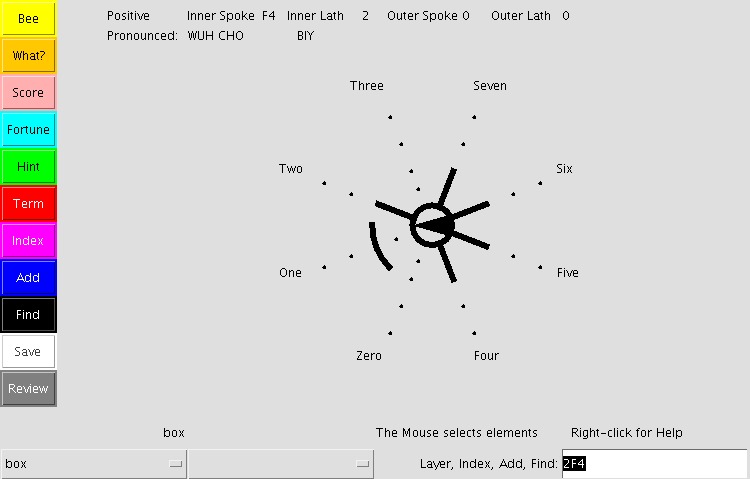
Articulation shows how a term (and therefore a glyph) fits within a sentence. The design document lays out the details here, but we are just going to hit the highlights.
All images in this tutorial were created using the game. The blue or black spokes are the added spokes in the examples below. The yellow or invisible spokes are not present. (clicking on a blue or yellow spoke will bring up a valid term, clicking on a black or invisible spoke will not)
FYI: Ideally, you should read this tutorial on a "big
screen" device (like a personal computer) and follow along by
duplicating the glyphs (on a hand-held device or using the game in a separate tab or window)
for each example.

Articulation supplies Qualifiers, Operators, Specifiers, Modifiers and Actors (verbs). Actors have already been exhaustively deconstructed here. We will cover each of the other Articulation categories in turn.
Some of these examples are a bit thin because we are using the term 'box' in places where time or people or places or math or logical entities might be more appropriate. The major reason for this is that we wanted to keep the examples as simple and consistent as possible. A secondary reason is that we wish to show that Articulation terms can be used anyplace that they make sense. A "Time Qualification" term like "before" might also be used to describe an entry in a dictionary.
In the examples below, the Articulation layer has been
highlighted (using the 'Hint' button). The blue outer spokes
specify the Articulation (or syntactic) portion of the term.
Qualifiers create clauses that describe or organize one or more
things. The descriptive form of a Qualifier is usually a
"prepositional phrase" in English. This would be something like,
"the ball behind the box is red", where "behind the box" is the
prepositional phrase. An organizational phrase with a Qualifier
would be, "most empty boxes are sad", where 'most' indicates that
the boxes have been divided or arranged.
If we wanted to say that boxes were uncommon hereabouts, we would
describe the box as 'occasional'. This term has the Interpolation
and Recognition spokes because it focuses attention on something
that is a small part of the 'normal flow' of things.
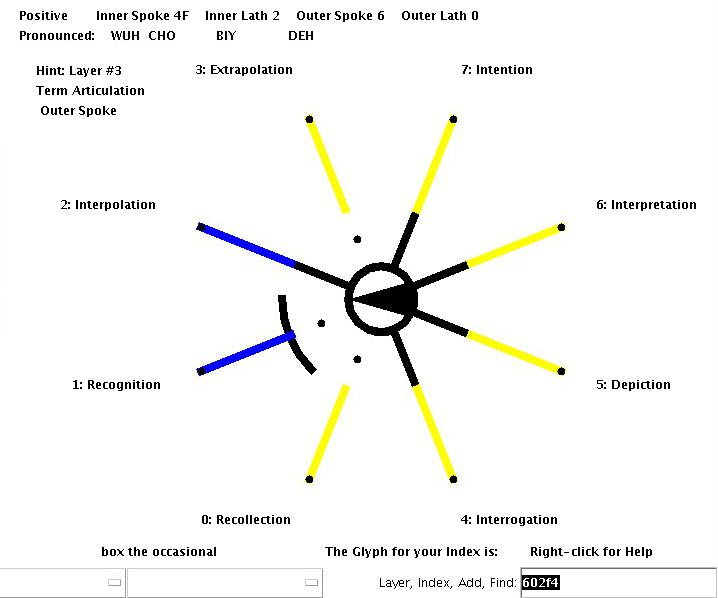
To describe the boxes that we have managed to obtain, we would
say, "the collected boxes". This term has the Interrogation,
Extrapolation and Recollection spokes because it recalls our
portion of a larger unknown quantity.
If you aren't sure how 'box' became plural, read the Description tutorial.
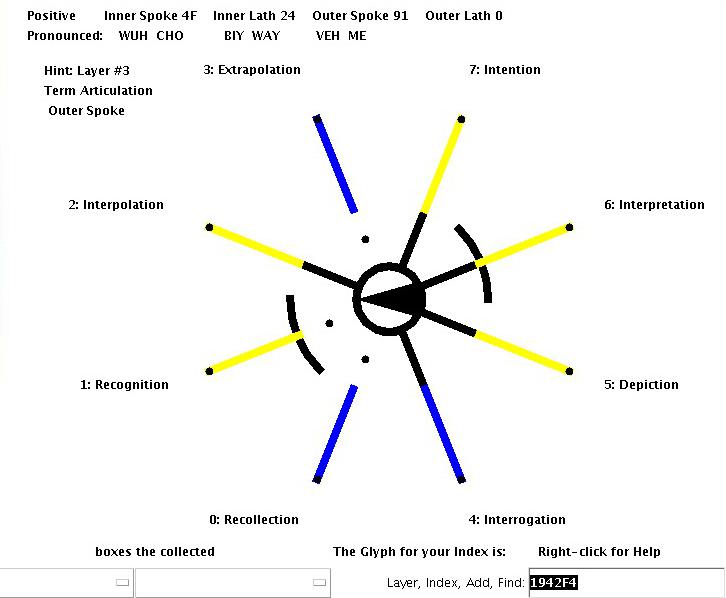
If I want to say that something is on the right side of my box, I
would say, "to the right of the box". This term has the Depiction,
Interpolation and Recollection spokes because it places the box
within a larger, known scheme of things.
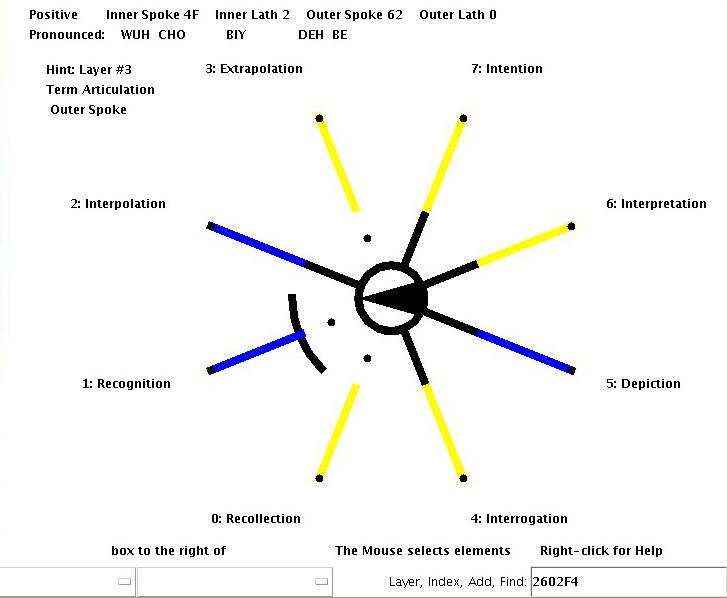
In the example above, notice that the term "box to the right of"
is displayed in the lower left hand corner of the image rather
than the English "to the right of the box". This order is used
because a glyph is read from the inside to the outside. The inner
spokes and laths are read before the outer spokes so 'box' comes
before 'to the right of'.
The words "the box" are not present in the example
glyphs because Instrumentation does not require a direct article
(and there is no room for any articles when a glyph is otherwise
Articulated).
Instrumentation is designed to be used by people who can't see one
another and probably have never met. A person who receives a glyph
can not tell the difference between "the box" and "a box" unless
"the box" has already been introduced and distinguished from its
boxy brethren as "the
original box".
If I wanted to buy a box I would inquire as to, "the value of the
box". This term has the Depiction, Interrogation, Recognition and
Recollection spokes because it assesses a questionable quantity.
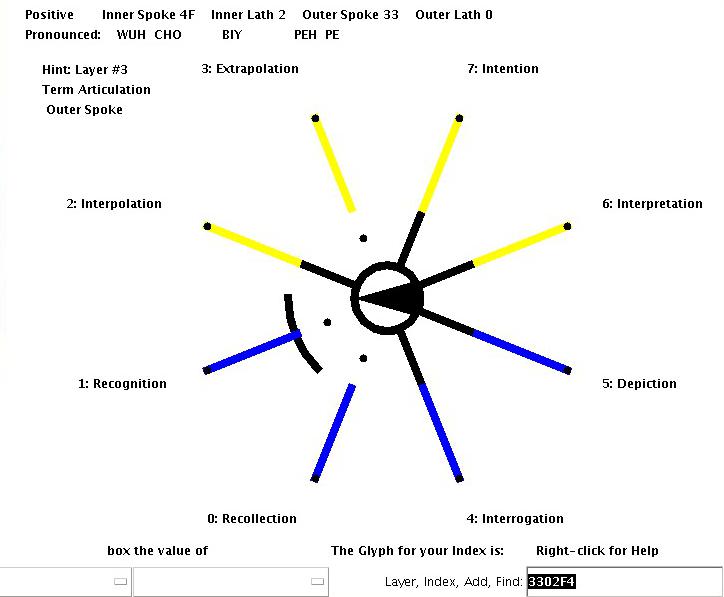
Operators define or create relationships between multiple things. These examples only show a single thing because we are only showing a single glyph, but you are welcome to imagine other glyphs or create them using the game.
Common examples of Operators in English would be "one plus
two" or "you and me".
The time operators can be used with non-temporal objects. We
might be waiting for, "the next box". This term has the
Interpretation, Extrapolation and Recognition spokes because it
assumes that the current progression (of boxes) will continue.
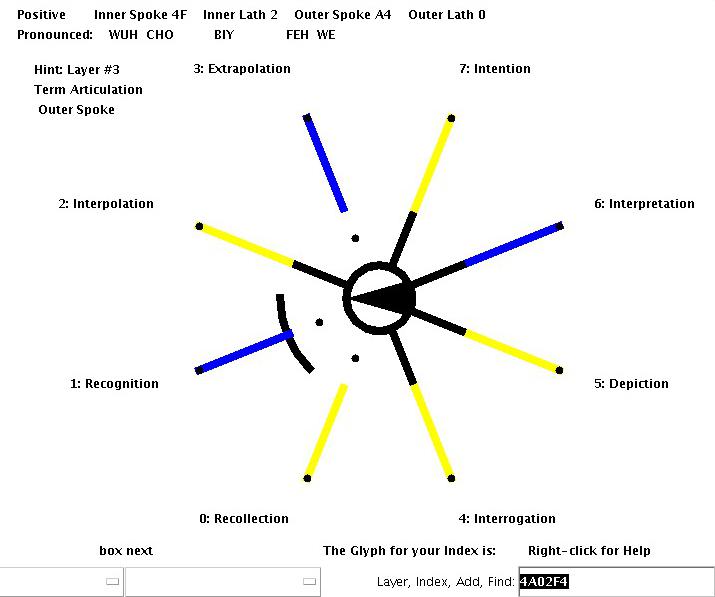
If this box played a pivotal role in vanquishing The Bad
People(TM), we might be, "honoring the box". (No, I don't know how
the box did that. Maybe it contained an anvil and it fell on
them.) This term has the Interpretation, Interrogation,
Extrapolation, Interpolation and Recognition spokes because
'honor' is never a simple thing, but "you know it when you see it
(sometimes)".
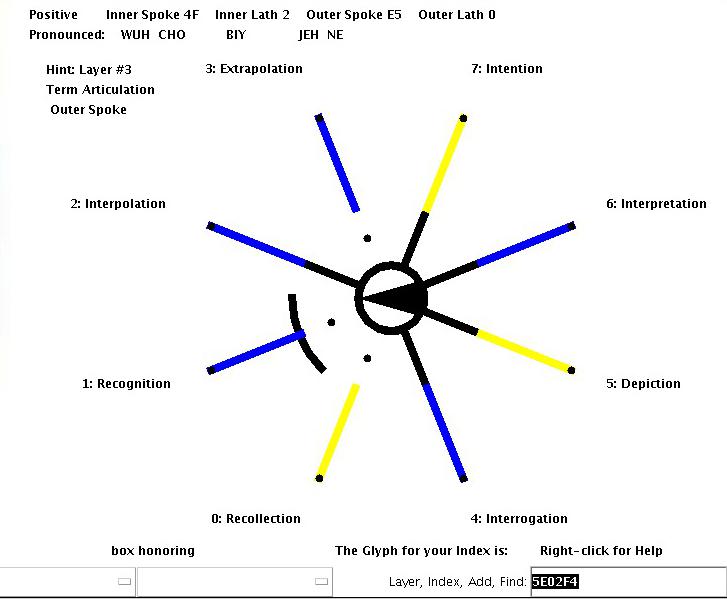
If some other thing was less honorable than our box (it is
an awesome box), we would say that thing, "is less than the box".
This term has the Interpretation, Depiction, Interpolation,
Recognition and Recollection spokes because we are estimating its
worth based on our experience (with honorable boxes).
![[it] is less than the box [it] is less than our awesome box](boxles.jpg)
If we wanted to do something when we find a box, we would say,
"do something 'on case of a box' being found". This term has the
Interpretation, Depiction, Interrogation, Interpolation and
Recognition spokes because it specifies an alternative action
based on a potential condition.

Specifiers identify single things. Modifiers change single things or distill single things from collective entities.
Common examples of Specifiers in English would be "the (original)
box" or "my box".
Common examples of Modifiers in English would be "deduce as
guilty" (using deductive logic) or "the standard deviation is
five" (reducing the kurtosis of a Gaussian distribution to a
single value).
Objects are all Specifiers. If I gave you a box, I would say, "It is now 'your box', cherish it always". This term has the Intention, Interpretation, Extrapolation and Recollection spokes because we are remembering that the box belongs to someone other than ourselves.
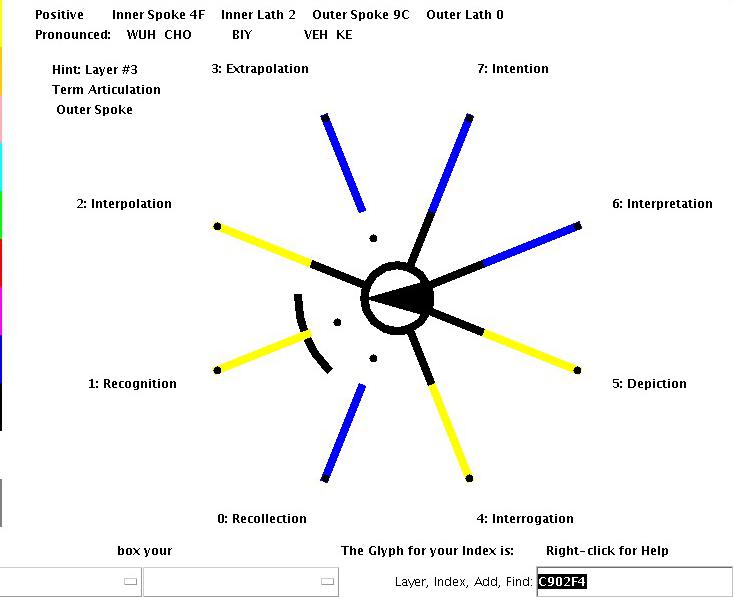
Classes are mostly Specifiers. If I wanted something to happen to
all the boxes, I would say, "Make the change 'for each box'". This
term has the Intention, Interpretation, Interrogation,
Interpolation and Recognition spokes because it involves an action
or condition for (all) the elements of a collection of unspecified
size.
![for each box [something comes] for each box](boxech.jpg)
Purposes are mostly Modifiers. If this box is your home, you might say "Environmental control 'is a feature of the box'". This term has the Intention, Interpretation, Depiction, Extrapolation, Interpolation and Recollection spokes because a 'feature' is an internal or external element of a larger system which may be defined in multiple ways.
![is
feature of is feature of [my boxy home]](boxfet.jpg)
Operations are all Modifiers. If I was talking about assorted
chocolates, I might say "The two hundred candy flavors come 'in
combination by box'". (OK, "in combination by eighteen" is
more likely [for the math majors in the audience], but I'm
thinking inside the box here)
This term has the Intention, Interpretation, Depiction,
Interrogation, Extrapolation, Interpolation and Recollection
spokes because it may require every type of qualification except
Recognition (because the order of the elements in a mathematical
'combination' doesn't matter). 'Overqualified' terms (such as 'in
combination by') are usually defined by the spokes they lack
(because it is
easier to remember exceptions).
![in combination by box [chocolates] in combination by box](boxcmb.jpg)